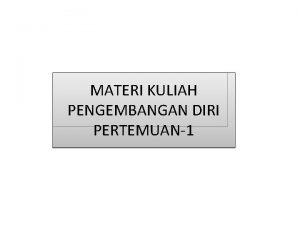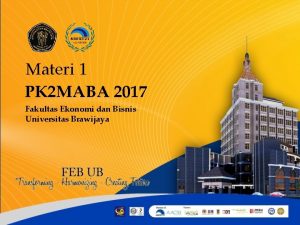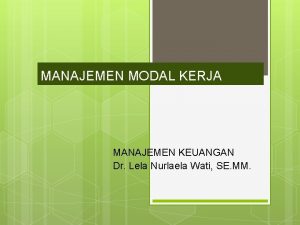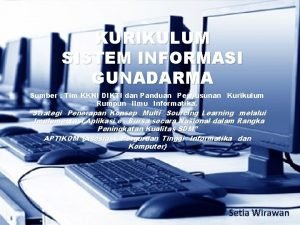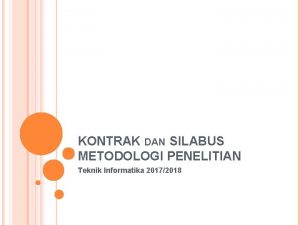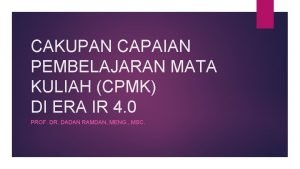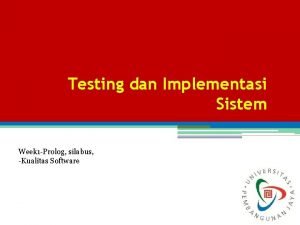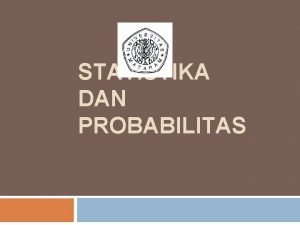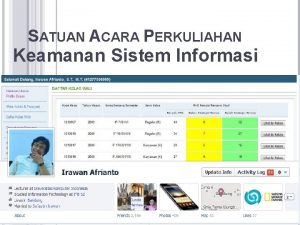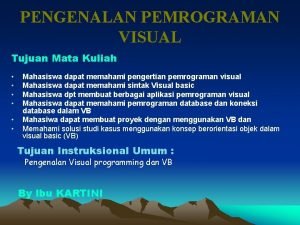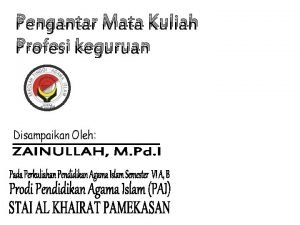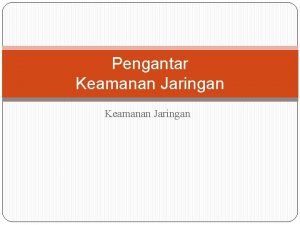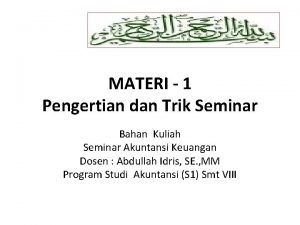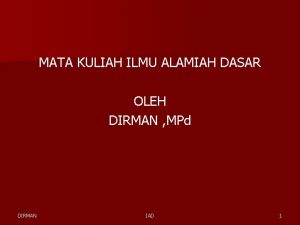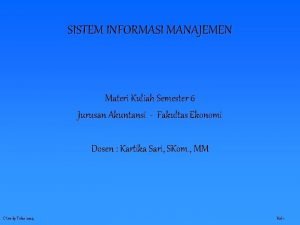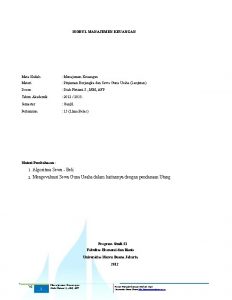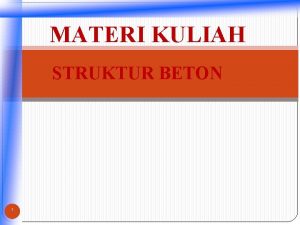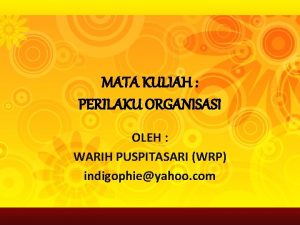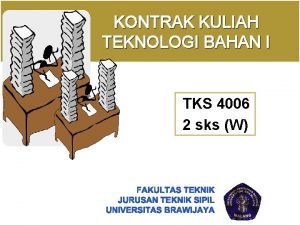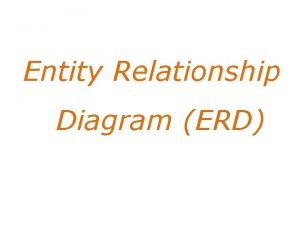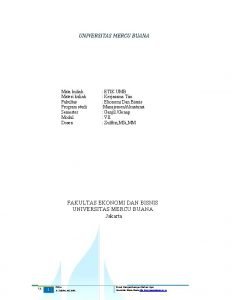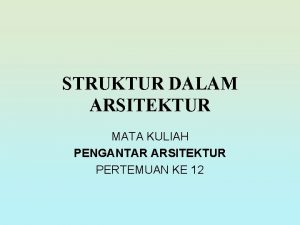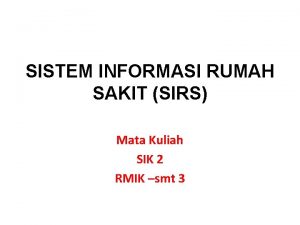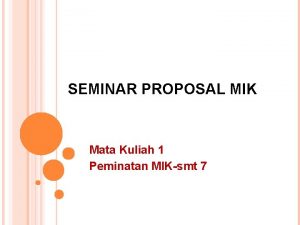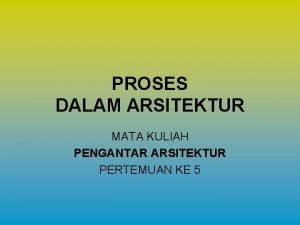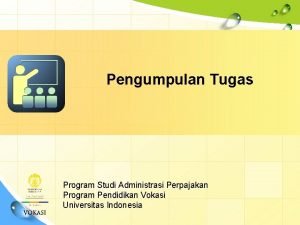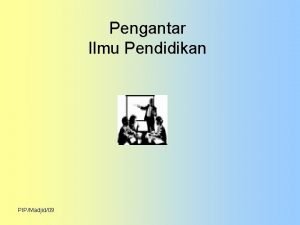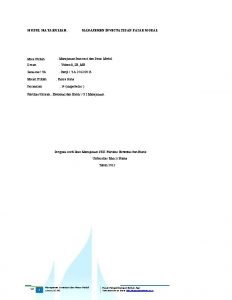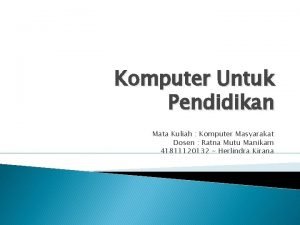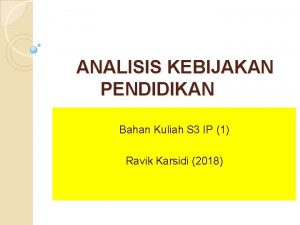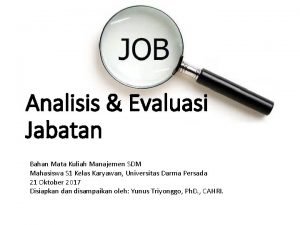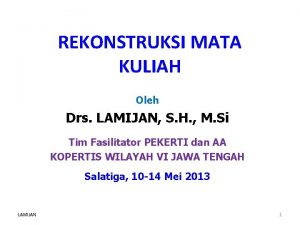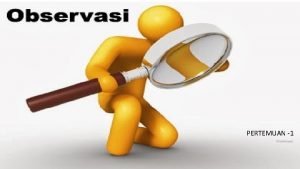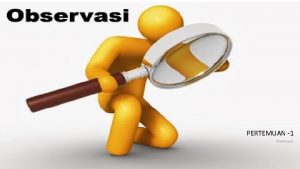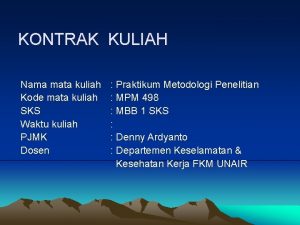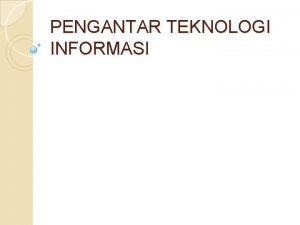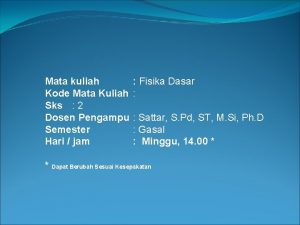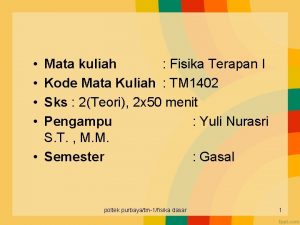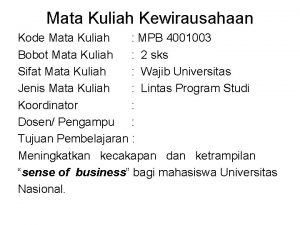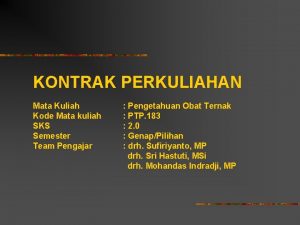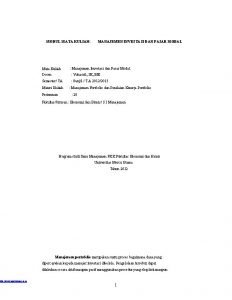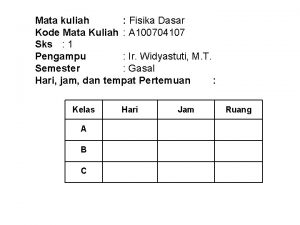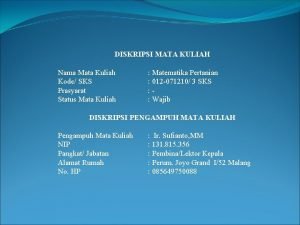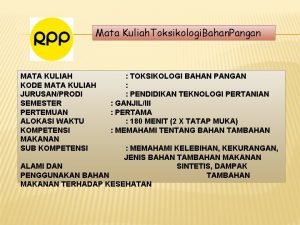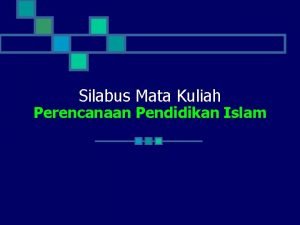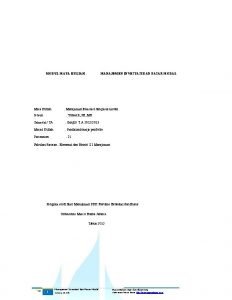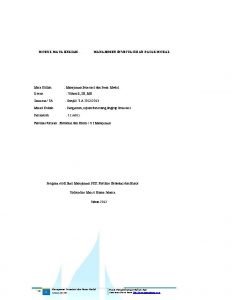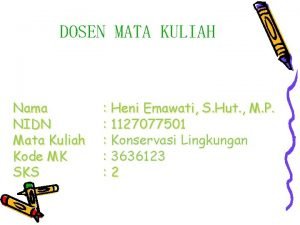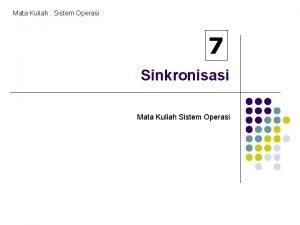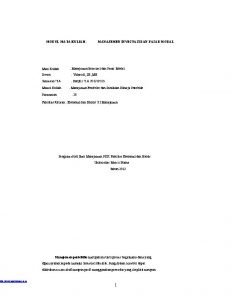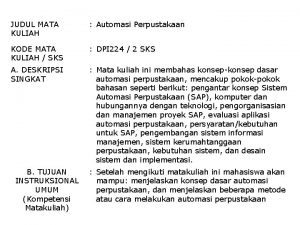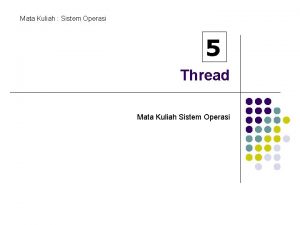Strategic Planning for Information System Mata kuliah ini





























































- Slides: 61

Strategic Planning for Information System Mata kuliah ini memberikan konsep dasar perencanaan strategis sistem informasi. Erwin Sutomo S 1 Sistem Informasi

What is Strategic Planning Anyhow ? Introduction

121 Strategic ? • Strategy means consciously choosing to be clear about your company’s direction in relation to what’s happening in the dynamic environment. • With this knowledge, you’re in a much better position to respond proactively to the changing environment.

The fine points of strategy are as follows : (1) • Establishes unique value proposition compared to your competitors • Executed through operations that provide different and tailored value to customers • Identifies clear tradeoffs and clarifies what not to do 121

The fine points of strategy are as follows : (2) • Focuses on activities that fit together and reinforce each other • Drives continual improvement within the organization and moves it toward its vision 121

121 Strategy is not : • Best practice improvement • Execution • Aspirations • A vision • Learning • Agility • Flexibility • Innovation • The Internet (or any technology) • Downsizing • Restructuring • Mergers/Consolidation • Alliances/Partnering • Outsourcing

121 What is a strategic plan? (1) • Simply put, a strategic plan is the formalized roadmap that describes how your company executes the chosen strategy. • A plan spells out where an organization is going over the next year or more and how it’s going to get there. • Typically, the plan is organization-wide or focused on a major function such as a division or a department.

121 What is a strategic plan? (2) • A strategic plan is a management tool that serves the purpose of helping an organization do a better job, because a plan focuses the energy, resources, and time of everyone in the organization in the same direction.

Strategic plans and business plans aren’t the same concepts • A strategic plan : – Is for established businesses and business owners who are serious about growth – Helps build your competitive advantage – Prioritizes your financial needs – Provides focus and direction to move from plan to action 121

Strategic plans and business plans aren’t the same concepts • A business plan : – Is for new businesses, projects, or entrepreneurs who are serious about starting up a business – Helps define the purpose of your business – Helps plan human resources and operational needs – Is critical if you’re seeking funding – Assesses business opportunities – Provides structure to ideas 121

121 What are the big planning pitfalls? • • • Relying on bad information or no information Ignoring what your planning process reveals Being unrealistic about your ability to plan Planning for planning sake Get your house in order first Don’t copy and paste

What are the components of a strategic plan? • • • Strategy and culture Internal and external The Balanced Scorecard perspectives Market focus Where are we now? Where are we going? How will we get there? 121

121 The Elements of a Strategic Plan • Strategic Review • Mission • Values Where are we now ? How are we going to get there? • Strategic Objectives • Goals • Priorities • Action Items • Strategies • Scorecard • Execution • Vision • Competitive Advantage Where are we going?

An outline of a typical strategic plan (1) • Mission statement: To define the organization’s core purpose. Why do we exist? • Vision statement: To explain where you are headed, your future state. To formulate a picture of what your organization’s future makeup will be and where the organization is headed. What will our organization look like in 5 to 10 years from now? 121

An outline of a typical strategic plan (2) • Values statement or guiding principals: To clarify what you stand for and believe in. • SWOT: To assess the particular strengths, weaknesses, opportunities, and threats that are strategically important to your organization. (You may or may not choose to include your SWOT in your strategic plan but as supporting documentation. ) 121

An outline of a typical strategic plan (3) • Competitive advantage: What can your organization potentially do better than any other organization? • Strategic objectives: To connect your mission to your vision. Strategic objectives are longterm, continuous strategic areas that get you moving from your mission to achieving your vision. What are the key activities that you need to perform in order to achieve your vision? 121

An outline of a typical strategic plan (4) • Strategies: To establish a guide that matches your organization’s strengths with market opportunities to position your organization in the mind of the customer. Does your strategy match your strengths with how you will provide value and be perceived by your customers? 121

An outline of a typical strategic plan (5) • Short-term goals/priorities/initiatives: To set goals that converts the strategic objectives into specific performance targets. Effective goals clearly state what, when, how, who and are specifically measurable. What are the 1 - to 3 -year goals you are trying to achieve to get to your strategic objectives? 121

An outline of a typical strategic plan (6) • Action items/plans: To set specific actions plans that lead to implementing your goals. Are your action items comprehensive enough to achieve your goals? • Scorecard: To measure and manage your strategic plan. What are the key performance measures you can track in order to monitor if you are achieving your goals? 121

An outline of a typical strategic plan (7) • Financial assessment: To determine if your strategic plan makes financial sense. Do the estimated revenue projections exceed your estimated expenses? 121

An effective plan and execution require several elements : (1) • Purpose-driven: A plan based on a mission and a real, true competitive advantage is key. Without it, what is the point of the plan or the organization? • Integrated: Each element supports the next. No objectives that are disconnected from goals and no strategies that sit all alone. 121

An effective plan and execution require several elements : (2) • Systematic: Don’t think of the plan as one big document. Instead, give it life by breaking into executable parts. • Dynamic: Not a static document, but a living document. 121

An effective plan and execution require several elements : (3) • Holistic: All areas of organization are included. Don’t plan based on departments first because you risk limiting your thinking. Plan by thinking about the organization as a whole entity and then implement on a department by department basis. 121

An effective plan and execution require several elements : (4) • Understandable: Everyone gets it. If anyone, from the top of the organization to the bottom, does not understand the plan or how they fit in, it won’t work. • Realistic: You can implement it. Don’t overplan. Make sure you have the resources to support the goals you decide to focus on. 121

The Evolving Role of Information Systems and Technology in Organizations: A Strategic Perspective Chapter 1

121 Preface (1) • Information technology has become inextricably intertwined with business. • In industries such as telecommunications, media, entertainment and financial services, where the product is already or is being increasingly digitized, the existence of an organization crucially depends on the effective application of information technology (IT).

121 Preface (2) • With the emergence of e-commerce, the use of technology is becoming just an accepted, indeed expected, way of conducting business. • Consequently, organizations are increasingly looking toward the application of technology not only to underpin existing business operations but also to create new opportunities that provide them with a source of competitive advantage.

121 Preface (3) • To manage information systems and information technology (IS/IT) strategically, it is helpful to understand how the role of technology-based information systems has evolved in organizations. • While organizations today want to develop a more ‘strategic’ approach to managing IS/IT, many have probably arrived at their current situation as a result of various short-term ‘tactical’ decisions regarding IS/IT.

121 Preface (4) • Many organizations would no doubt like to rethink their investments, or even begin again with a ‘clean sheet’, but unfortunately have a ‘legacy’ resulting from a less than strategic approach to IS/IT in the past. • Learning from experience—the successes and failures of the past—is one of the most important aspects of strategic management

Information System - Information Technology (1) • IT refers specifically to technology, essentially hardware, software and telecommunications networks. It is thus both tangible (e. g. with servers, PCs, routers and network cables) and intangible. • ICT is generally used instead of IT to recognize the convergence of traditional information technology and telecommunications 121

Information System - Information Technology (2) • IS as the means by which people and organizations, utilizing technology, gather, process, store, use and disseminate information. It is thus concerned with the purposeful utilization of information technology. • Some information systems are totally automated by IT. 121

Information System - Information Technology (3) 121

Structure for information systems in an organization • Structure for information systems in an organization, based on a stratification of management activity into: – Strategic planning – Management control – Operational control 121

Typical planning, control and operational systems 121

Transition between computer and information management (1) 121

Transition between computer and information management (2) • To achieve effective Information (Systems) Management, a new top-down approach was required, depends on the role of IS in relation to the outside world. 121

Three stage model transition role of IS (1) 121 • Delivery: – IS issues are mainly internal—improving the ability to deliver and support the systems and technology. – Achieving top management credibility as a valuable function is a prime objective. This means improving delivery performance, not necessarily providing users with what they really need

Three stage model transition role of IS (2) • Reorientation: – establishing good relationships with the main business functions – supporting business demands through the provision of a variety of services as computing capability spreads through the business. – The issues focus is extended outside the ‘DP department’ and a key objective is to provide a valued service to all business function management. 121

Three stage model transition role of IS (3) • Reorganization: – The high level of awareness created both ‘locally’ in the business area and ‘centrally’ in senior management creates the need for a reorganization of responsibilities designed to achieve integration of the IS investment with business strategy and across business functions. – A key objective becomes the best way of satisfying each of the differing business needs through a coalition of responsibilities for managing information and systems. 121

121 Early Views And Models: Up To 1980 from the 1960 s onwards—the DP era; from the 1970 s onwards—the MIS era.

The DP And MIS Eras: The Lessons Learned (1) • There have been essentially three parallel threads of evolution that have enabled more extensive and better information systems to be developed: – Hardware—reducing cost and size, improving reliability and connectivity, enabling the system to be installed closer to the business problem. 121

The DP And MIS Eras: The Lessons Learned (2) • There have been essentially three parallel threads of evolution that have enabled more extensive and better information systems to be developed: – Software, more comprehensive & flexible operating software & improved languages, enabling business applications to be developed more quickly, with greater accuracy & by staff with less experience. In addition, there was an increased availability of application packages available ‘off the shelf ’. 121

The DP And MIS Eras: The Lessons Learned (3) • There have been essentially three parallel threads of evolution that have enabled more extensive and better information systems to be developed: – Methodology, ways of organizing and carrying out the multiplicity of tasks, in a more coordinated, synchronized and efficient way to enable ever more complex systems to be implemented and large projects to be managed successfully. 121

121 DP lessons (1) • Need to understand the process of developing complete information systems, not just the programs to process data. • More thorough requirements and data analysis to improve systems linkages and a more engineered approach to designing system components.

121 DP lessons (2) • More appropriate justification of investments by assessing the economics of efficiency gains and converting these to a return on investment. • Less creative, more structured approaches to programming, testing and documentation to reduce the problems of future amendments. More discipline was introduced with ‘change control procedures’ and sign-off on specifications and tests.

121 DP lessons (3) • Extended project management that recognized the need for coordination of both user and DP functions and the particular need to establish user management in a decisive role in the systems development—the user had to live with the consequences.

121 DP lessons (4) • The need for planning the interrelated set of systems required by the organization. Better planning produced overall improvements in systems relevance and productivity.

121 MIS lessons (1) • Justification of IS investments is not entirely a matter of return on investment/financial analysis. • Databases require large restructuring projects and heavy user involvement in data definition —data integration had been weak based on the project by project DP approach.

121 MIS lessons (2) • The IS resource needs to move from a production to a service orientation to enable users to obtain their own information from the data resource—the information centre concept. • Need for organizational policies, not just DP methodologies.

121 MIS lessons (3) • Personal computers and office systems enable better MIS to be developed, provided that users and IS specialists both focus on the information needs rather than the technology.

121 The Three-era Model • The prime objective of using IS/IT in the eras differs: – Data processing, to improve operational efficiency by automating information-based processes. – Management information systems, to increase management effectiveness by satisfying their information requirements for decision making. – Strategic information systems, to improve competitiveness by changing the nature or conduct of business.

Trends in the evolution of business IS/IT 121

Aligning the IS Direction and Priorities to the Business Direction and Priorities Introduction

121 IS and Business Direction • Over the past few years, companies have felt increasing pressure to improve efficiency and effectiveness, decrease costs, and enhance competitive position. • Companies can attain these goals through aligning the IS direction with the business direction. • Proper alignment can have a considerable impact on a company’s financial performance

What is alignment? How do you achieve alignment? • When all IS activities provide optimal support for the business goals, objectives, and strategies, then IS and the business are in alignment. • True alignment implies that the IS strategy and the business strategy are developed concurrently rather than sequentially so that technology enables the business strategy. 121

121 Alignment components

121 Business value and alignment

121 Business and IS plan alignment

Identify organizations that have not achieved alignment (1) • Canceled projects • Redundant projects • Projects that do not deliver the intended value • Lack of coordination between the business and IS • Systems that do not meet the needs of the business 121 • Systems that cannot respond quickly to the demands of the business • Business users unsatisfied with IS services • Reactive, constant fire fighting • Never enough resources; fighting for resources

Identify organizations that have not achieved alignment (2) • Churning of priorities; • Systems and tools not slow progress fully utilized • Uninvolved business • Lack of integration of management systems • High IS costs with a sense • IS decisions made as a of low value result of emotion or opinions 121

With Planning, Companies Transform IS 121
 Etika profesi mahasiswa
Etika profesi mahasiswa Materi pengembangan diri mahasiswa
Materi pengembangan diri mahasiswa Erd perkuliahan
Erd perkuliahan Matkul ekonomi pembangunan ub
Matkul ekonomi pembangunan ub Mata kuliah pelayanan prima
Mata kuliah pelayanan prima Contoh metode keterikatan dana
Contoh metode keterikatan dana Mata kuliah sistem informasi gunadarma
Mata kuliah sistem informasi gunadarma Silabus metode penelitian
Silabus metode penelitian Mata kuliah ilmu kelautan unpad
Mata kuliah ilmu kelautan unpad Deskripsi mata kuliah ekonomi mikro
Deskripsi mata kuliah ekonomi mikro Mata kuliah creative writing
Mata kuliah creative writing Cpmk
Cpmk Cjr mata kuliah kewirausahaan
Cjr mata kuliah kewirausahaan Mata kuliah testing dan implementasi sistem
Mata kuliah testing dan implementasi sistem Mata kuliah statistika dan probabilitas
Mata kuliah statistika dan probabilitas Silabus sejarah pendidikan islam
Silabus sejarah pendidikan islam Mata kuliah keamanan sistem informasi
Mata kuliah keamanan sistem informasi Rekonstruksi mata kuliah adalah
Rekonstruksi mata kuliah adalah Mata kuliah ekonomi islam ub
Mata kuliah ekonomi islam ub Tujuan mata kuliah
Tujuan mata kuliah 3 pilar kunci guru profesional
3 pilar kunci guru profesional Materi tentang keamanan jaringan
Materi tentang keamanan jaringan Mata kuliah seminar akuntansi
Mata kuliah seminar akuntansi Mata kuliah penyuntingan
Mata kuliah penyuntingan Kurikulum institusional
Kurikulum institusional Mata kuliah ilmu alamiah dasar
Mata kuliah ilmu alamiah dasar Mata kuliah fisika lingkungan
Mata kuliah fisika lingkungan Pengantar aplikasi komputer (spss)
Pengantar aplikasi komputer (spss) Mata kuliah sistem produksi
Mata kuliah sistem produksi Materi kuliah sistem informasi manajemen
Materi kuliah sistem informasi manajemen Silabus mata kuliah pengantar bisnis
Silabus mata kuliah pengantar bisnis Relevansi mata kuliah menyimak dengan berbicara
Relevansi mata kuliah menyimak dengan berbicara Materi mata kuliah manajemen keuangan
Materi mata kuliah manajemen keuangan Q beton
Q beton Contoh soal struktur beton bertulang
Contoh soal struktur beton bertulang Mata kuliah perilaku organisasi
Mata kuliah perilaku organisasi Mata kuliah manajemen proyek sistem informasi
Mata kuliah manajemen proyek sistem informasi Soal uas perkembangan peserta didik beserta jawabannya
Soal uas perkembangan peserta didik beserta jawabannya Bahan i
Bahan i Apa itu entity relationship diagram
Apa itu entity relationship diagram Mata kuliah mercu buana
Mata kuliah mercu buana Mata kuliah pengantar arsitektur
Mata kuliah pengantar arsitektur Ocusert adalah
Ocusert adalah Mata kuliah sik
Mata kuliah sik Silabus mata kuliah seminar proposal skripsi
Silabus mata kuliah seminar proposal skripsi Mata kuliah pengantar arsitektur
Mata kuliah pengantar arsitektur Mata kuliah perencanaan dan pengendalian produksi
Mata kuliah perencanaan dan pengendalian produksi Mata kuliah administrasi perpajakan ui
Mata kuliah administrasi perpajakan ui Kontrak perkuliahan
Kontrak perkuliahan Mata kuliah farmasi ugm
Mata kuliah farmasi ugm Mata kuliah manajemen investasi dan pasar modal
Mata kuliah manajemen investasi dan pasar modal Erwin setyo kriswanto
Erwin setyo kriswanto Ticcit adalah
Ticcit adalah Mata kuliah manajemen resiko
Mata kuliah manajemen resiko Mata kuliah geografi ui
Mata kuliah geografi ui Mata kuliah gambar bentuk
Mata kuliah gambar bentuk Mata kuliah pengantar arsitektur
Mata kuliah pengantar arsitektur Mata kuliah analisis kebijakan pendidikan
Mata kuliah analisis kebijakan pendidikan Mata kuliah analisis jabatan
Mata kuliah analisis jabatan Pengunduran diri gunadarma
Pengunduran diri gunadarma Rekonstruksi mata kuliah
Rekonstruksi mata kuliah Fakultas teknologi industri gunadarma
Fakultas teknologi industri gunadarma

